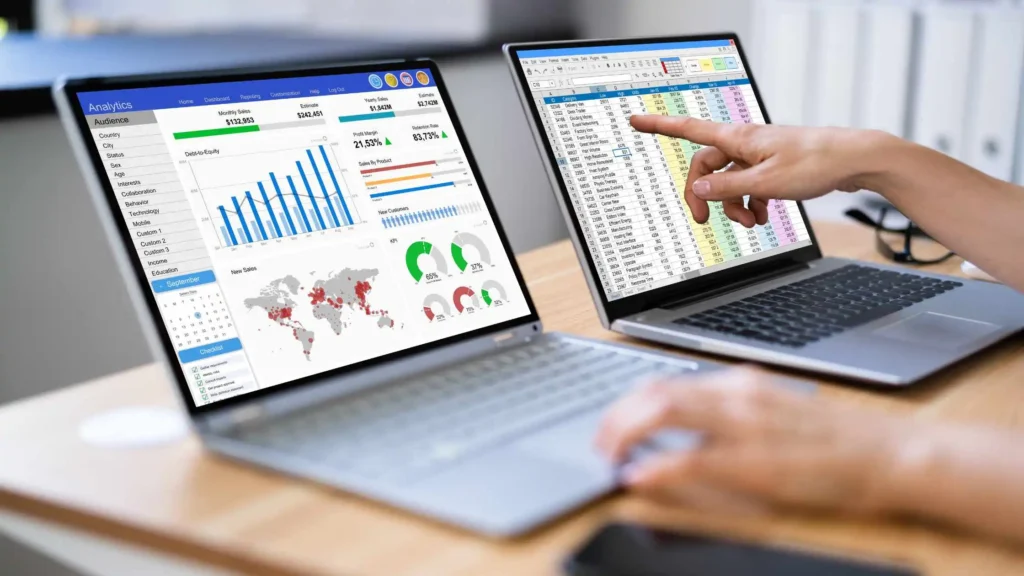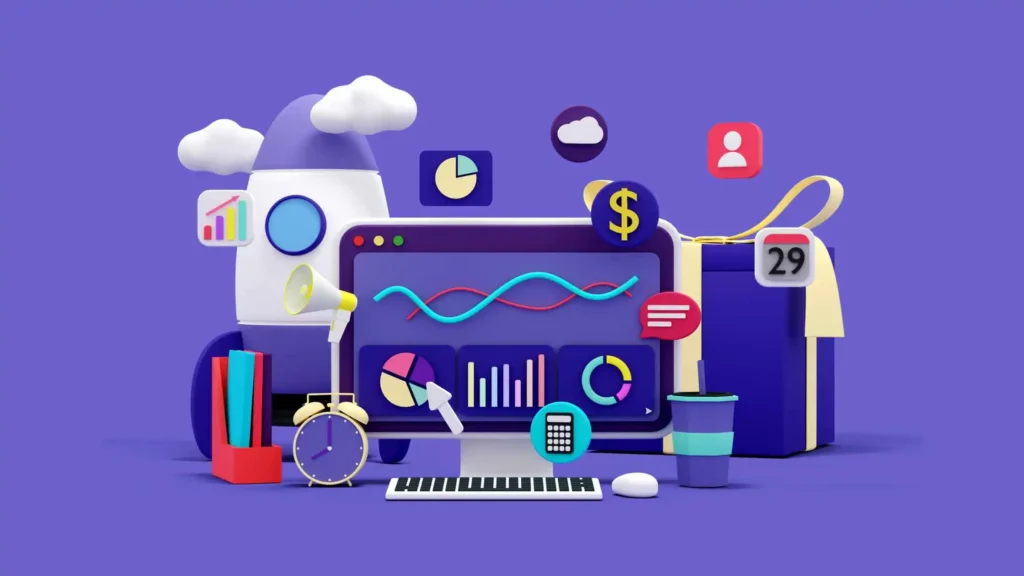Do you want to learn how to embed Power BI reports and dashboards in other applications?
If yes, Congrats! Now you’re going to make it happen!
Power BI is a powerful business intelligence tool that allows users to visualise and analyse data intuitively and interactively.
It provides various features and functionalities to create informative reports and dashboards.
One of the critical advantages of Power BI is its ability to embed reports and dashboards in other applications, allowing users to access and interact with data seamlessly.
So let’s go ahead to find out more interesting things!

Understanding Power BI Embedding
Power BI embedding refers to integrating Power BI reports and dashboards into other applications, such as websites, portals, or custom-built applications.
This integration allows users to view, interact with, and analyse data without leaving the context of their application.
Embedding enhances the user experience by providing seamless access to data insights and eliminating the need to switch between different tools or interfaces.
How to Embed Power BI Reports and Dashboards
Embedding Power BI reports and dashboards involve a series of steps.
Let’s go through each step in detail:
Step 1: Publish the Power BI Report
Before you can embed a Power BI report, you need to publish it to the Power BI service.
The report should be designed and structured according to your requirements, with all the necessary visualisations, filters, and interactions in place.
Once the report is ready, you can publish it to your Power BI workspace.
Step 2: Configure Embedding Settings
After publishing the report, you must configure the embedding settings to determine who can access the embedded information and their interactivity level.
Power BI provides options to set permissions, apply filters, and define other settings to control the embedded experience.
Step 3: Generate Embed Code
In this step, you generate the embed code for the Power BI report.
The embed code contains the necessary HTML and JavaScript to embed the report into other applications.
Power BI provides a straightforward process to generate the embed code, which can be customised based on your specific requirements.
Step 4: Add Embed Code to Other Applications
Finally, you can add the generated embed code to the desired location within your target application.
This could be a web page, a portal, or a specific section of a custom-built application.
Once the code is added and the application is deployed, users can access the embedded Power BI report and interact with the data.
Benefits of Embedding Power BI Reports and Dashboards
Embedding Power BI reports and dashboards offers several benefits for organisations and users.
Let’s explore some of the key advantages:
Improved Data Accessibility
By embedding Power BI reports and dashboards in other applications, data becomes easily accessible to users within their familiar working environment.
They can access the reports without switching between tools or platforms, saving time and effort.
This accessibility promotes data-driven decision-making and empowers users with valuable insights.
Enhanced User Experience
Embedding provides a seamless user experience by integrating Power BI reports and dashboards within the context of other applications.
Users can navigate the application and access relevant data insights without disruptions.
The embedded reports inherit the look and feel of the hosting application, creating a consistent and intuitive user interface.
Real-time Data Updates
Embedded Power BI reports can be configured to receive real-time data updates.
This ensures that users can always access the latest information and insights without manual refreshes.
Real-time updates enable timely decision-making and empower users with accurate and up-to-date data.
Increased Collaboration
Embedding facilitates collaboration by allowing multiple users to access and interact with the same data set simultaneously.
Users can share insights, annotations, and comments within the context of the embedded reports, fostering collaboration and knowledge sharing.
This collaborative environment enhances teamwork and drives better outcomes.
Brand Consistency
Organisations can customise the visual elements when embedding Power BI reports and dashboards to match their applications’ branding and design language.
This ensures a consistent and cohesive user experience, reinforcing brand identity and promoting a professional appearance.
Do I need a Power BI Pro license to embed reports?
A Power BI Pro license is required for users who consume embedded reports.
However, the report authors or developers who create and configure the embedded reports need a Power BI Pro or Premium license.
Use Cases for Power BI Embedding
Power BI embedding can be leveraged across various industries and use cases.
Here are some examples:
Sales and Marketing Dashboards
Embedding Power BI reports in sales and marketing applications allows teams to track key performance indicators, monitor sales pipelines, and analyse marketing campaign effectiveness.
Sales representatives can have real-time visibility into their performance metrics, enabling them to make data-driven decisions and prioritise their activities.
Can I embed Power BI reports in mobile applications?
Yes, Power BI supports embedding reports in mobile applications.
You can use the Power BI mobile SDK to embed reports and dashboards in iOS and Android applications, providing mobile users with on-the-go access to data insights.
Executive Dashboards
Executives and senior management can benefit from embedded Power BI dashboards that provide a consolidated view of business performance across different departments and metrics.
These dashboards can include financial data, operational metrics, sales trends, and other relevant information, empowering executives to monitor the organisation’s health and make informed strategic decisions.
Are there any limitations to embedding Power BI reports and dashboards?
While embedding Power BI reports, and dashboards offer excellent flexibility, there are some limitations to consider.
For instance, certain features or visualisations may not be fully supported in the embedded mode.
Reviewing the documentation and ensuring that your specific requirements align with the capabilities of Power BI embedding is essential.
Customer Support Analytics
Embedding Power BI reports in customer support applications can help support teams gain insights into customer satisfaction, ticket volumes, response times, and other support-related metrics.
Agents can access the embedded reports to understand customer behaviour patterns, identify areas of improvement, and provide personalised assistance based on historical data.
Can embedded Power BI reports be customised to match my application’s branding?
Yes, you can customise the visual elements of embedded Power BI reports, such as colours, logos, and fonts, to align with your application’s branding.
This customisation helps create a cohesive user experience and maintains brand consistency.
Supply Chain Monitoring
Embedding Power BI dashboards in supply chain management systems allow organisations to monitor inventory levels, track shipments, analyse supplier performance, and optimise logistics operations.
The embedded reports provide real-time visibility into the supply chain, enabling proactive decision-making and reducing bottlenecks or delays.
Is embedding Power BI reports secure?
Power BI provides robust security features to ensure the confidentiality and integrity of embedded reports.
Access to embedded reports can be controlled through permissions and authentication mechanisms.
Additionally, Power BI supports encryption in transit and at rest, further enhancing embedded data security.
Financial Reporting
Financial institutions can leverage embedded Power BI reports to enhance financial reporting and analysis.
The reports can consolidate data from multiple sources, provide visualisations of financial metrics, and offer drill-down capabilities for detailed analysis.
This enables finance professionals to gain insights into profitability, cash flow, budget adherence, and other critical financial aspects.
Can I embed Power BI reports in my custom web application?
Yes, Power BI provides capabilities to embed reports in custom web applications using the Power BI JavaScript API.
This allows you to integrate Power BI reports into your application’s user interface seamlessly and provide a cohesive user experience.
Conclusion
Embedding Power BI reports, and dashboards in other applications offer numerous benefits, including improved data accessibility, enhanced user experience, real-time data updates, increased collaboration, and brand consistency.
By following the step-by-step process, organisations can seamlessly integrate Power BI into their existing applications and empower users with valuable data insights.
With its versatility and wide range of use cases, Power BI embedding continues to revolutionise how businesses analyse and visualise data.
More Resources You May Find Helpful
- How to embed Power BI reports and dashboards in other applications
- It’s Time to Use Power Automate with Microsoft Power BI
- Here’s How to Securing and Governing Data in Microsoft Power BI
- It’s Time to Create Real-Time Dashboards in Microsoft Power BI
- Integrating Microsoft Power BI with Other Microsoft Products











